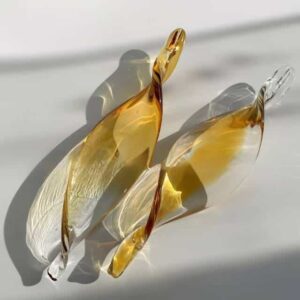From Fire to Fascination: The Illuminating Journey of Hand-Blown Glass Lamps
Published on 2023年 8月 22日 by iartglass

Introduction
Hand-blown glass—a mesmerizing dance of molten material and breath, resulting in intricate, ethereal designs. From its origins in the fiery crucibles of ancient civilizations to the contemporary designs that grace modern homes, the art of glass-blowing has persisted and evolved, ever radiant in its charm and craftsmanship.
At its heart, the story of hand-blown glass is one of transformation, from humble sand to brilliant crystal. Yet, it’s not just about vases, decanters, or sculptures. Glass’s malleability and transparency made it a prime candidate for various household items—most notably, the captivating luminosity of glass lamps.
Visit the depths of this age-old art with us at Siga Art Glass.
The Ancient Beginnings of Hand-Blown Glass
The Cradle of Craft: Earliest Civilizations and Glass

The earliest evidence of glass making can be traced back to the Phoenicians, where rudimentary beads and small ornaments dazzled with their novelty. However, it was the Romans who truly took the art to greater heights, popularizing it across their vast empire and ensuring that its techniques were refined and expanded. Not to be left out, the Egyptians added their touch with the creation of vibrantly colored beads and amulets, making glass a treasure of the ancient world.
Echoes from the Past: How Ancient Techniques Shape Today’s Artisans
- Millefiori: A technique that involved fusing multicolored glass rods to create intricate patterns, reminiscent of blossoming flowers.
- Cane working: Involving the pulling of thin rods of glass, later to be incorporated into designs.
- Incalmo: Joining two separately blown entities while they are still hot, creating a seamless bond.
Such ancient techniques, though millennia old, still find their echo in today’s workshops. The dedication of artisans from ages past has been passed down, ensuring that the timeless elegance of hand-blown glass remains alive in the hands of contemporary craftsmen, including the master artists at Siga Art Glass.
The Renaissance of Glass Blowing in Europe
European Hubs: Crystallizing Artistry
When thinking about the heart of glass craftsmanship in Europe, one can’t bypass the magical canals of Venice, more specifically, the island of Murano. As the medieval era gave way to the Renaissance, European cities, including Murano, Bohemia, and later, the regions of France and Germany, began elevating glassware from mere household utilities to true art forms.
Discover the magic behind each piece, from the curvatures to the colors.
A New Dawn: The Birth of Glass Lamps
With advancements in artistic techniques came innovation in functionality. As Europe transitioned from torches and candles, the inception of glass lamps presented an evolution in illumination. Hand-blown glass became the preferred medium, due to its ability to diffuse light gently and create mesmerizing effects through intricate designs and colorations.
The Marriage of Artistry and Functionality: Introduction of Hand-Blown Glass Lamps
Illuminating Evolution: Lamp Designs Through the Ages
Over the centuries, glass lamps have evolved from rudimentary oil vessels with wicks to magnificent chandeliers gracing grand ballrooms and contemporary designs fit for modern homes. The timeline can be traced as:
- Ancient Oil Lamps: Simple, functional designs filled with oil and wicks.
- Medieval Candelabras: Merging metal and glass, often ornate and decorative.
- Victorian Gas Lamps: Introduction of gas, with more elaborate glass shades.
- Modern Electric Lamps: Diverse in designs, from minimalist to grand, with safety and aesthetics in mind.
For those interested in the intricacies of these design evolutions, our deep dive into the incredible benefits of hand-blown glass lamps provides captivating insights.
Siga Art Glass: Lighting the Path Forward
In this ever-evolving tapestry of design and function, Siga Art Glass stands out as a beacon of modern craftsmanship married with traditional techniques. From the mesmerizing swirls of the Dark Blue River Wave Chandelier to the simplistic elegance of the Crystal Glass Pendant Globe Light, Siga Art Glass encapsulates the true essence of artistry in illumination. The brand’s unique contribution? A blend of timeless tradition with forward-thinking designs, ensuring every piece is both a nod to the past and a vision of the future.
Materials and Techniques: The Magic Behind Hand-Blowing
Crafting Beauty: Tools and Techniques Unveiled
The allure of hand-blown glass lies not only in the finished product but also in the journey it undertakes from raw material to art. Essential tools and techniques include:
- Glass Furnace: The heart of the operation, where raw materials melt into a molten state.
- Blowing Pipe: A long metal tube, used for blowing air into the molten glass.
- Marver: A flat, often metal surface used to shape the glass.
- Jacks: Tools for shaping, cutting, and tweaking the molten glass.
- Glory Hole: A reheating furnace to keep the glass malleable during the crafting process.
- Annealing Kiln: Where finished products are slowly cooled, ensuring strength and longevity.
For a deeper exploration into this meticulous process, check out our detailed post on how to create beautiful hand-blown glass.
Regional Flair: Techniques that Differ by Geography
From the far East to the western coasts, glass-blowing techniques have been influenced by local traditions, resources, and artistic flair.
- Asian Techniques: Often incorporate detailed painting, intricate engravings, and inclusion of precious metals.
- European Techniques: Known for their clear, crystalline glass, and complex shapes.
- Middle Eastern Techniques: Introduced the use of colored sands and dyes, creating vibrant glass artifacts.
The Global Spread and Modern Innovations
A Global Glow: The Rise of Hand-Blown Glass Lamps Worldwide
From the palaces of Europe to the homes in Asia, the hand-blown glass lamp transcended borders, becoming a symbol of luxury, craftsmanship, and artistic prowess. Trade routes, both overland and maritime, played a pivotal role in this global spread, introducing diverse
cultures to the charm and utility of these luminous creations.
Innovations Unleashed: Modern Twists on Ancient Craft
Today’s hand-blown glass lamps are not just about illumination but are a statement of style, design, and technological integration.
- LED Integration: Modern lamps efficiently merge traditional glass with LED technology.
- Dynamic Color Schemes: With the use of advanced dyes and techniques, achieving gradients, neon hues, and multi-chromatic designs.
- Smart Home Compatibility: Many glass lamps are now designed to integrate seamlessly with smart home systems.
Siga Art Glass: Continuing a Time-Honored Tradition
In a world where machinery and automation dominate, Siga Art Glass upholds the revered tradition of hand craftsmanship, ensuring every piece tells a story. Their commitment to excellence is seen in every swirl, every hue, and every curve of their creations.
- Pioneering Designs: The Murano Hand-Blown Double Bubble Glass Ball epitomizes innovation rooted in tradition.
- Craftsmanship Workshops: For those keen on witnessing art in action, Siga Art Glass offers glimpses into their processes, keeping the age-old techniques alive for newer generations.
- Eco-friendly Initiatives: Ensuring sustainable production without compromising on the beauty of the products, like the ethereal Suspended Hand-Blown Glass Abstract Gourd.
In the vast universe of hand-blown glass, Siga Art Glass shines brightly, an emblem of history, craftsmanship, and innovation.
Hand-Blown Glass Lamps Today: A Fusion of Past and Present
Trending Illuminations: The Modern Glass Lamp Market
Today, the hand-blown glass lamp market dances to the tune of both tradition and innovation. While the essence of ancient craftsmanship still lingers, consumers crave unique, personalized, and multi-functional pieces. Popular trends include:
- Minimalistic Designs: Clean lines, subtle colors, and designs that complement modern interiors.
- Statement Pieces: Bold and oversized lamps that become the focal point of a room.
- Customizable Lamps: Personal touches, from color choices to shape alterations, allowing customers to have a say in the artistry.
Wondering where the next big thing in hand-blown glass is being crafted? Discover top destinations for your next exquisite purchase.
Eco-Effulgence: Sustainability in Glass Lamp Production
The world is more eco-conscious than ever, and the glass-blowing industry is no exception. Many artisans are adopting practices like:
- Recycled Glass Use: Melting and reshaping previously used glass, cutting down on waste.
- Energy-Efficient Furnaces: Reducing the carbon footprint of the production process.
- Sustainable Packaging: Using recycled or biodegradable materials for packing and shipping.
Conclusion: The Eternal Glow of Hand-Blown Glass Lamps
Hand-blown glass lamps are more than just objects of illumination—they are time capsules, holding within their curves and colors the tales of ancient civilizations, the genius of bygone artisans, and the aspirations of modern-day innovators. Their light does more than dispel darkness; it tells stories, ignites passions, and brings art into everyday life.
As we stand on the threshold between past grandeur and future potential, it’s essential to remember and celebrate the hands that craft these luminous wonders. Siga Art Glass, with its commitment to tradition and innovation, encapsulates this spirit perfectly. So, the next time you switch on a lamp or marvel at a chandelier, pause for a moment. Appreciate the artistry in every curve, the story in every shimmer. And remember, in a world that often rushes past beauty, there’s a timeless elegance to be found in hand-blown glass, especially if it’s a masterpiece from Siga Art Glass.




